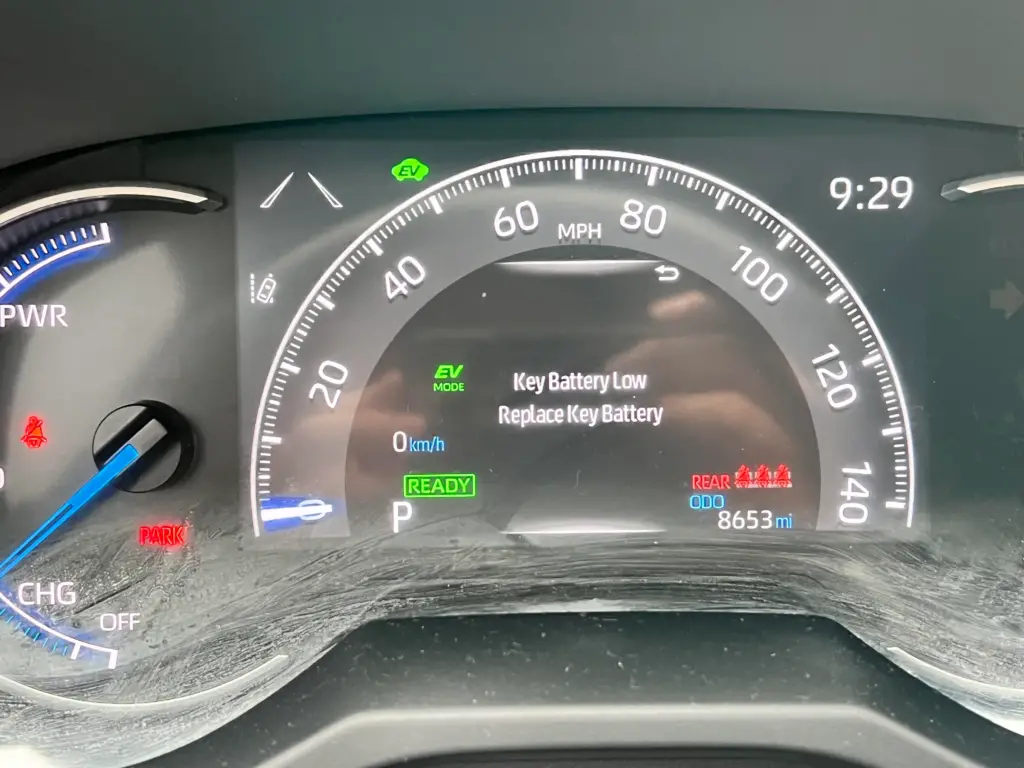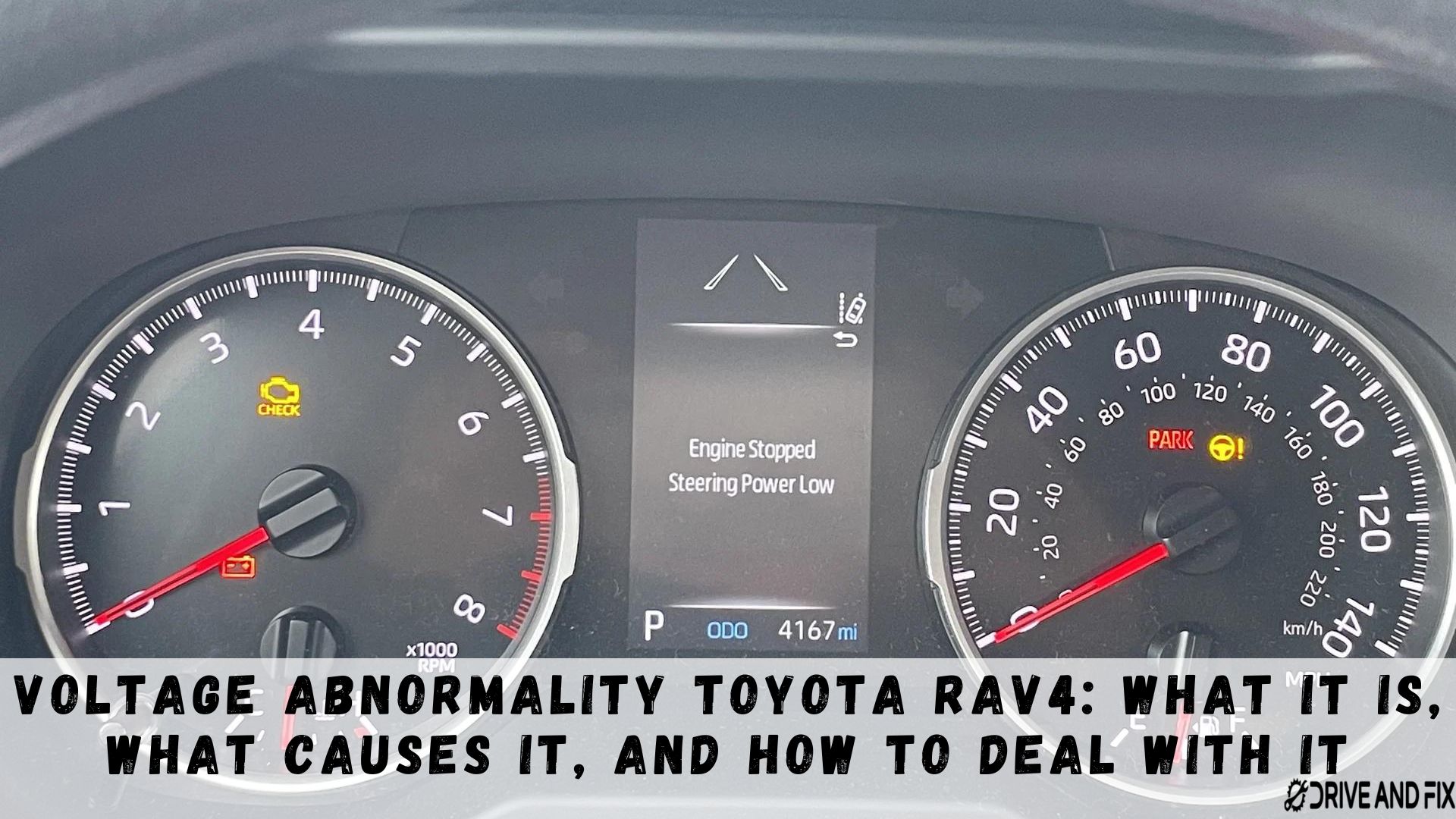Imagine driving your Toyota RAV4 on a sunny day, enjoying the smooth ride and the spacious interior. Suddenly, you see several warning messages flashing on your dashboard, telling you something is wrong with your vehicle. Your lights start to flicker, your steering feels heavy and sluggish, and your engine sounds like it’s struggling. You wonder what’s going on and how to fix it. You may be one of the many owners facing voltage abnormality Toyota RAV4 problem.
This is a condition where the battery voltage is not within the normal range, causing various malfunctions and hazards to your vehicle. If you want to learn more about voltage abnormality in Toyota RAV4 and how to protect yourself from it, keep reading.
Signs Of Voltage Abnormality Toyota RAV4

Voltage abnormality is when your battery voltage is not within the normal range of 11 to 14 volts. This can cause malfunctions and hazards to the vehicle’s performance and safety. Some of the signs of voltage abnormality are:
- Warning messages on the dashboard include activated EPD, flickering lights inside, and low voltage abnormality. These messages tell you there is a problem with the power supply circuit of the brake actuator or the steering system.
- Dimming or brightening of the interior lights, especially when turning the steering wheel or using other accessories. That shows a fluctuation in the battery voltage due to a faulty alternator, a parasitic battery drain, or a loose connection.
- Difficulty starting the vehicle. To signal a low battery positive voltage or a parasitic battery drain that has drained the battery too much.
- Abnormal heating or swelling of the battery. It means there is a short circuit, an over-voltage, or a thermal runaway defect that can cause fire or explosion.
Causes Of Voltage Abnormality
- An abnormality in the power supply circuit of the brake actuator or the steering system
These circuits control the anti-lock braking system (ABS) and the vehicle stability control system (VSC), which require a stable and sufficient voltage. If there is a problem with these circuits, such as a short circuit, an open circuit, or a loose connection, they can affect the battery voltage and cause warning messages on the dashboard.
- A faulty alternator or a parasitic battery drain
The alternator charges the battery and supplies power to the vehicle’s electrical system. If the alternator is defective or damaged, it can overcharge or undercharge the battery, resulting in voltage fluctuations. A parasitic battery drain is a defect where something draws power from the battery even when the vehicle is turned off, such as a faulty radio, light, relay, switch, sensor, module, etc. This can drain the battery too much and cause difficulty starting the vehicle or a dead battery.
- A lightning strike or other atmospheric disturbances
These can cause a surge or a spike in the voltage, damaging the battery or other electrical components. A surge is a sub-cycle disturbance lasting less than half a cycle and mostly less than a millisecond. A spike is a variation that lasts for a 0.5 cycle to about 2 seconds
Tips And Tricks To Avoid Voltage Abnormality
- Check your battery condition and level regularly using a voltmeter or a battery tester.
The battery should have a standard voltage of 11 to 14 volts. If the battery is weak, recharge it or replace it with a new one.
- Keep your battery terminals clean and tight.
Dirty or loose terminals can cause resistance and voltage drop. Use a wire brush or a terminal cleaner to remove any corrosion or dirt. Also, use a wrench to tighten the terminal bolts and nuts.
- Avoid leaving accessories on when not in use.
Accessories such as radios, lights, relays, switches, sensors, modules, etc., can draw power from the battery even when the vehicle is turned off. This can cause parasitic battery drain and drain the battery too much. You should turn off all accessories before leaving your car and disconnect any unnecessary devices.
- Use quality components for your vehicle.
Faulty or damaged components such as alternators, power supply circuits, fuses, wiring harnesses, etc., can cause voltage fluctuations, over-voltage, under-voltage, short-circuit, or open-circuit. You should use original or compatible components that meet the specifications and standards of your vehicle. Regularly inspect and replace any faulty or damaged parts soonest possible.
Effects Of Voltage Abnormality

- Malfunctions and damages to the electrical devices or components.
Voltage abnormality can affect the performance and efficiency of electrical devices or components, such as motors, relays, lights, sensors, modules, etc. Voltage abnormality can cause overheating, overloading, underloading, sparking, arcing, burning, or breaking of these devices or components.
- Hazards to the safety and reliability of the electrical system.
Voltage abnormality can cause fire, explosion, shock, or injury to the electrical system or device or the people using it. It can also cause instability, interference, noise, or distortion to the electrical system or device.
- Faults and errors in the battery system
Voltage abnormality can affect the battery system or device, such as electric vehicles (EVs), by causing overcharge, over-discharge, short-circuit, open-circuit, thermal runaway, etc. These faults can affect the battery state of charge (SOC), state of health (SOH), open circuit voltage (OCV), etc. These errors can affect the battery’s performance, safety, and lifespan.
How To Diagnose
To diagnose voltage abnormality, you must measure and compare it with the expected or standard value. You must also identify the source and type of voltage abnormality, such as sag, swell, surge, or interruption. Different methods and tools for diagnosing voltage abnormality exist depending on the application and situation. Some of them are:
- Using a digital multimeter or a voltmeter to measure the voltage drop across a circuit or a component. Voltage drop is the difference between a circuit or component’s input and output voltage. It indicates the resistance or impedance of the circuit or the part. A high voltage drop means a high resistance or impedance, which can cause voltage abnormality. You should use a low-voltage (0 to 1V) scale for voltage drop testing and compare the measured value with the specification or standard value.
- Using a Zener diode, an IC, or a voltage regulator protects your DC circuit from too much voltage. These devices can provide a constant output voltage irrespective of input voltage as long as it is within their maximum rating. You can use a Zener diode in reverse bias or ICs like NCP372 or MAX16126/MAX16127 with over-voltage protection features.
- You can use an equivalent circuit model and a long short-term memory neural network to diagnose battery faults based on voltage abnormality. This method can predict and detect voltage problems in real-time by monitoring battery voltage and comparing it with the expected value from the model and the network. This method can diagnose various battery faults, such as overcharge, over-discharge, short-circuit, open-circuit, etc.
FAQs

What are the types of abnormal voltage conditions?
There are four types of abnormal voltage conditions: sag, swell, surge, and interruption. A sag temporarily reduces the standard AC voltage, usually caused by a short circuit. A swell is the opposite of sag and refers to the increase of power frequency voltage, usually caused by a load reduction. A surge is a sub-cycle disturbance lasting less than half a cycle and mostly less than a millisecond, usually caused by lightning or switching. An interruption means the complete loss of voltage, usually caused by a line outage or a blown fuse.
How can I protect my DC circuit from too much voltage?
One way to protect your DC circuit from too much voltage is to use a Zener diode in reverse bias. A Zener diode will always give you a constant output voltage irrespective of input voltage as long as it is within its maximum rating. For over-voltage protection, you can also use ICs like NCP372 or MAX16126/MAX16127.
What are the causes of voltage imbalance?
Voltage imbalance is a condition where the voltages in a three-phase system are unequal or have different phase angles. Various factors, such as unequal load distribution, impedance, single-phase faults, open-delta transformers, etc., can cause voltage imbalance. Voltage imbalance can affect the performance and efficiency of three-phase motors and other equipment.
How can I diagnose and solve voltage abnormality in my Toyota RAV4?
According to our previous paragraphs, voltage abnormality in Toyota RAV4 is a condition where the battery voltage is below or above the normal range of 11 to 14 volts. The leading causes of voltage abnormality are low battery positive voltage and parasitic battery drain. To diagnose low battery positive voltage, inspect the fuse, the battery condition, and the wiring harness between the fuse and the skid control ecu. To diagnose parasitic battery drain, you need to measure the current drawn from the battery using an ammeter or a multimeter and identify which circuit is causing it by removing fuses one by one. You must repair or replace the faulty components affecting the battery voltage to solve voltage abnormality.
Final Thoughts
Voltage abnormality is when the voltage is not within the normal range, causing various problems and damages to the electrical system or device. It can affect the performance and safety of your electrical devices or components, such as motors, relays, lights, sensors, modules, etc. It can also cause fire, explosion, shock, or injury to the electrical system, device, or people who use it. To avoid these issues, you must diagnose and solve voltage abnormalities immediately. This write-up gives you a comprehensive overview of voltage abnormality, including its types, causes, effects, diagnosis methods, and solutions. We have also shared some tips and recommendations to prevent Toyota RAV4 voltage abnormality. We hope this article has been informative and helpful for you.
You May Also Like:
How To Dispose Of Old Gasoline – The Dos And Don’ts
The Essential Guide to Blown AC Fuse In Car Symptoms
Why Car AC Stops Blowing Cold Air After A While -Troubleshooting Tips
Blown Fuse Car Won’t Start? Here’s What You Need to Know
How Often To Change Engine Air Filter Toyota?


